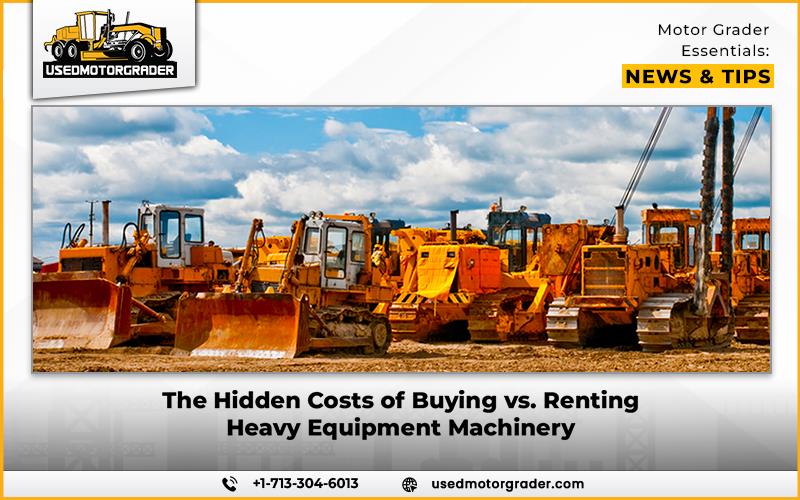No one can undermine the exceptional growth of the heavy construction equipment market. The manufacturers maximized their production levels, and the market witnessed the advanced machinery each passing day. The increase in the sale of heavy equipment market is mostly driven by the current ongoing construction projects and financial institutionalization. Both the government and private sectors are investing in construction, which makes it obvious that the trend also increases the business of heavy equipment. Therefore, investing in heavy equipment machinery is a major decision for any construction business.
Whether to buy or rent depends on multiple factors, including budget, construction duration, and long-term company objectives. While the upfront costs of purchasing equipment are easy to calculate, many hidden expenses often go unnoticed. Most contractors and fleet managers are unaware of the hidden cost of heavy equipment machinery that they are renting or buying. Similarly, renting may seem cost-effective on the surface, but it can come with unexpected costs as well. Thus, it is highly essential to thoroughly understand the various aspects that include these hidden costs and other expenses.
Depreciation and Resale Value
One of the most considerable overlooked expenses of purchasing or renting heavy equipment machinery is depreciation. As soon as a new machine goes into operation, its value begins to depreciate. Through time, wear and tear, technological innovation, and newer models becoming available can greatly lower the resale value of equipment owned. Companies that intend to sell their machines after a few years can discover that they recover much less than anticipated.
Maintenance and Repairs
Heavy equipment ownership involves the added costs of routine maintenance and sudden repairs. Regular servicing, replacement parts, and emergency breakdowns add up fast. Also, all these before and after operation services are handled by the owner of the equipment. Whether it’s the replacement of the part or maintaining it. Unlike rental machines, where maintenance is usually paid for by the rental agency, owners are responsible for the entire cost of keeping their machines operational. If a machine needs a major repair, it might result in expensive downtime and project overruns.
Storage and Transportation
The successful completion of a project demands correct storage for owned equipment to stop degradation and breakdown. Costs related to warehouse space as well as specialized storage facilities, emerge as necessary expenses for project completion. Moving heavy equipment machinery between different construction sites involves bearing the additional logistics costs. Consisting of heavy-duty trailers alongside fuel as well as experienced operators. The expenses incurred for logistics operations accumulate heavily into the company’s budget. Particularly when they maintain operations between multiple business sites.
Insurance and Taxes
Heavy equipment ownership entails full responsibility for its insurance and tax burdens. Insurance costs can be steep, particularly for costly machinery that needs extensive coverage. Property taxes and registration fees also contribute to the total cost of ownership. These costs might not be readily apparent when buying equipment but can add up over time.
The Hidden Costs of Renting Heavy Equipment
Renting is usually considered an economical option, but for extended projects, rental charges can be more than the cost of buying. Short-term rentals are ideal for temporary or specialty projects, but using rented heavy equipment machinery for the long haul can rapidly deplete company funds. Companies must thoroughly weigh whether the regular rental charges are financially viable versus buying.
Limited Availability and Downtime
Equipment rental depends on what resources are currently available to the rental company. Project completion can get delayed when businesses need specific machinery that is in high demand from rental companies. Rental companies enforce daily and systematic use limitations for their heavy equipment machinery. Which influences operational efficiency. Rental might not provide the most suitable solution for projects needing real-time machine operation.
Customization and Performance Limitations
Businesses using rental equipment cannot always access equipment with their precise requirements due to standardized options. Rental equipment offers fewer customization options for its specifications because modifications are not feasible for purchased equipment equipped with attachments and upgrades. The lack of essential features in a machine will result in reduced productivity on the job site.
Hidden Fees and Damage Costs
Renting might also include charges not directly obvious. Fuel, pickup, and delivery charges may pile up, which raises the price of the rental. Businesses can also be caught with repair bills when rented equipment gets damaged or comes back in poor condition. Even minor tears and wear could incur additional rental company charges.
Making the Right Decision
Purchasing is advantageous for businesses that operate on extended continuous projects, even though total expenses remain hidden. Companies working with varied and short-term jobs usually save money by renting equipment because they avoid ownership agreements.
Essential to reach a decision between purchasing and renting heavy equipment is both careful financial planning and detailed cost analysis. Companies should analyze both obvious cost components and lesser-obvious expenses to find the solution that suits their goals while supporting long-term expansion. High and low costs associated with buying or renting must become known so investors can make wise construction market choices that reduce expenses while enhancing operational performance.


